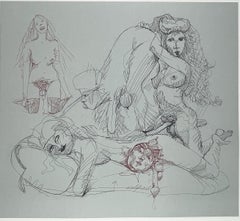Suzanne Valadon Art
Suzanne Valadon’s successful career as an artist defied the odds of her circumstances. One of only a few women artists in fin-de-siècle Paris whose primary subject was the female nude, her paintings, prints and drawings undermined social and artistic conventions while also recording the realities of her life.
Born Marie-Clémentine Valadon in 1865, she was the illegitimate child of a maid. At an early age, she and her mother moved to Montmartre, the epicenter of the Parisian avant-garde. Surrounded by a bohemian world at the height of its activity, she taught herself how to draw at the age of nine. Although she could not afford private lessons, Valadon was able to overcome the limitations of her marginalized social position by becoming a figure model, thus providing her direct entry into the artist’s studio, much-needed income, and opportunities and connections that would last a lifetime.
Between 1880 and 1890, Valadon became a sought-after model within the studios of some of the best-known Impressionist and Post-Impressionist artists. Under the pseudonym Maria, she posed for Pierre Puvis de Chavannes and Pierre-Auguste Renoir; she later assumed the name Suzanne at the suggestion of Henri de Toulouse-Lautrec. As she posed for these artists, she studied their techniques and methods, incorporating them into her work, which typically portrayed children, interior scenes, or portraits.
A drawing of 1890, La Mère de Suzanne Valadon et son Fils Maurice notably depicts the artist’s mother with Suzanne’s illegitimate son — the future landscape painter Maurice Utrillo. Valadon’s relationship with Toulouse-Lautrec, professional and intimate, was especially instrumental to her artistic development. He not only encouraged her after seeing some of her drawings but also introduced her to Edgar Degas, who would have a profound impact on Valadon’s career. One of the first to purchase her artworks, he became her mentor and remained a close friend throughout her life.
In the early 1890s, Degas introduced Valadon to soft-ground etching, a technique that required deeply incised lines, resulting in dark lines and thick contours of the figures depicted. Valadon’s etchings of women at their toilette of 1895 and 1896 reveal the influence of Degas’ works, which also informed Valadon’s signature drawing technique.
In Jeanne et son Chien, Valadon captures a private scene of a young woman seated on a settee with her dog at her feet. Although the identity of the figure is not definitively known, it possibly depicts her close friend Jeanne Wenz, who also modeled for Toulouse-Lautrec.
The artist’s distinctive heavy outlines encircle both the figure and her pet in Jeanne et son Chien, defining the curve of the model’s back, as well as her folded arm, outstretched leg, and foot that rests on the canine’s back as it dozes peacefully on the floor. Valadon here renders the settee and the fabric on which the model sits with notably lighter strokes and subtle shading — just enough to subtly define the folds of the cloth. The soft features of the model, particularly her face, are similarly delicately rendered, contrasting beautifully with the dark outlines.
Valadon was acutely aware of how one’s body positioning translated into non-verbal cues, and her time as a figure model — as the object of artists’ intense scrutiny — undoubtedly influenced the structure of her compositions. The dark outlines of the model’s outstretched leg provide visual entry into Jeanne et son Chien's scene, but the nude model remains occupied within the space of the scene, seemingly unaware of the artist’s presence and firmly absorbed in her examination of her leg. Valadon’s compositions often showcased models engaged in mundane activities, and here both the model and her canine companion are shown in a quiet, self-possessed moment, unfazed by the presence of anyone else in the room.
Valadon was one of the most innovative female artists of her day, and in addition to being celebrated by some of her most famous contemporaries, she held the distinction of being the first woman to gain entry into the Salon of the Société Nationale des Beaux-Arts. In addition to numerous gallery exhibitions, she contributed to the Salon d’Automne and the Salon des Indépendants throughout her lifetime.
At the early signs of her son’s mental illness, Valadon encouraged him to pursue painting and became his principal teacher, leading to the popular success for Utrillo that would be greater than her own. Valadon worked well into her 60s, and by the time of her death, had made over 450 oil paintings, 300 drawings, and more than 30 etchings.
Find original Suzanne Valadon art for sale on 1stDibs.
(Biography provided by Robert Simon Fine Art)
1890s Modern Suzanne Valadon Art
Etching
Late 20th Century Modern Suzanne Valadon Art
Etching
1970s Modern Suzanne Valadon Art
Etching
Early 20th Century Modern Suzanne Valadon Art
Engraving, Etching
1930s Modern Suzanne Valadon Art
Etching
1930s Modern Suzanne Valadon Art
Etching
1930s Modern Suzanne Valadon Art
Etching
Early 2000s Modern Suzanne Valadon Art
Etching
1930s Modern Suzanne Valadon Art
Etching
1930s Modern Suzanne Valadon Art
Etching
1930s Modern Suzanne Valadon Art
Etching
1930s Modern Suzanne Valadon Art
Etching
1940s Modern Suzanne Valadon Art
Etching
1890s Modern Suzanne Valadon Art
Etching
1890s Impressionist Suzanne Valadon Art
Pencil
1890s Modern Suzanne Valadon Art
Etching
1890s Modern Suzanne Valadon Art
Etching
Suzanne Valadon art for sale on 1stDibs.
Artists Similar to Suzanne Valadon
- 1stDibs ExpertApril 5, 2022Suzanne Valadon is a French painter known for her still lifes, portraits, landscapes and florals. She began working as a model in 1880 for many different artists until being the first woman painter admitted to the Societe Nationale des Beaux-Arts. While her work couldn’t be pigeonholed into one movement, she did display symbolism and post-impressionistic qualities. Shop a selection of Suzanne Valadon pieces from some of the world’s top art dealers on 1stDibs.

